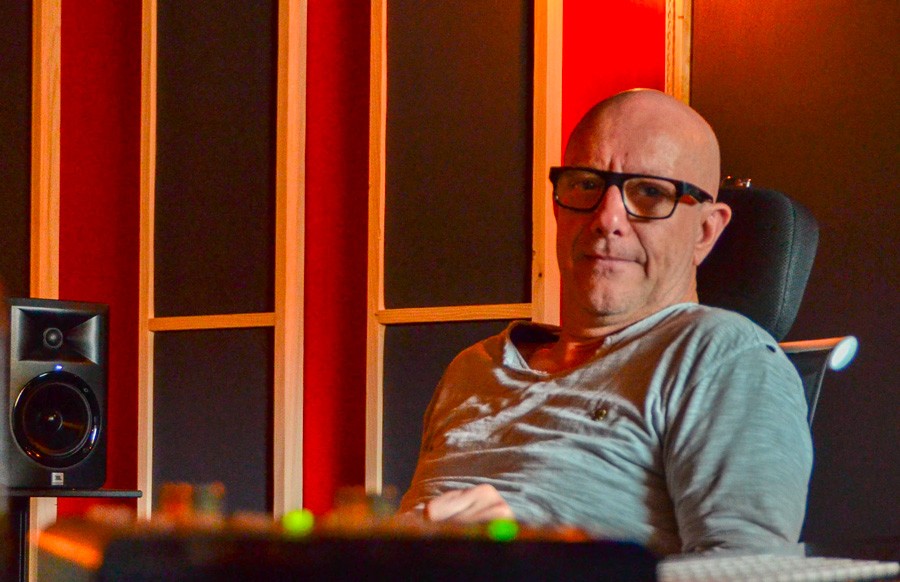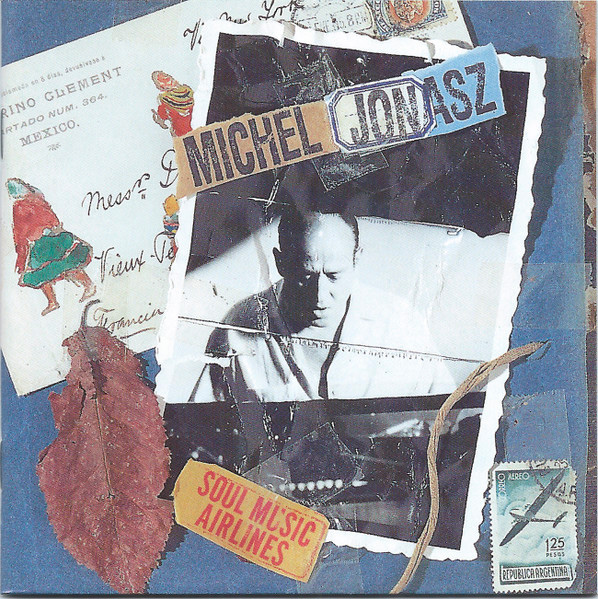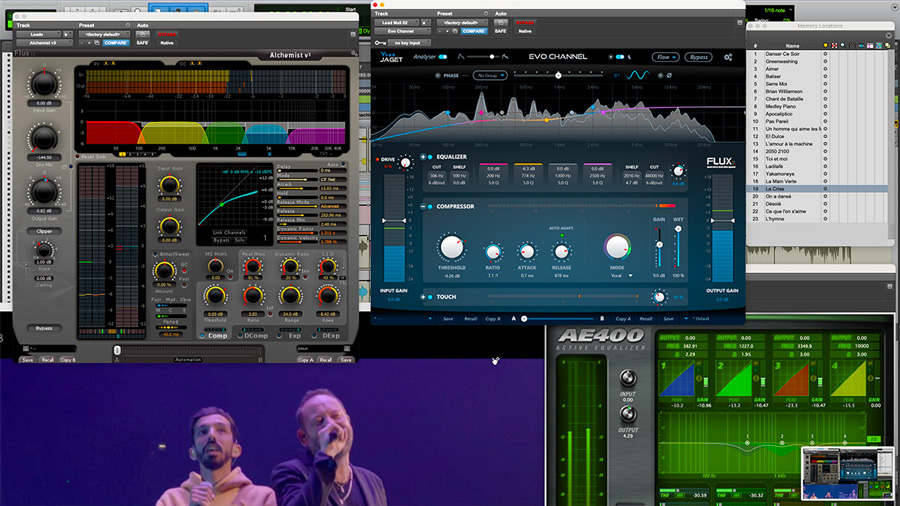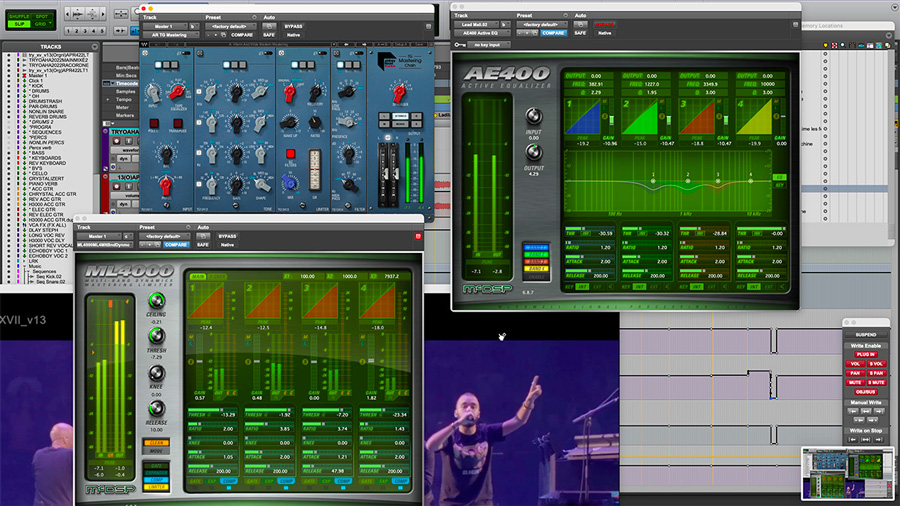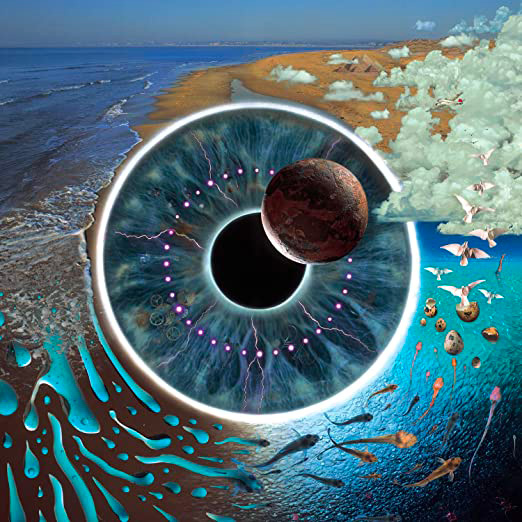Yves Jaget has been working for many years with major French and international artists. But he’s more than just that: musician, studio and live sound engineer, artistic director; this sound expert records and mixes essential albums, including those of Zazie and William Sheller.
He also builds his own equipment. Passionate about electronics, Yves has been building audio devices since he first started. From his first console, which he copied from a Malcolm Hill desk (the model used on AC/DC tours at the time) and which he used on his first live shows – to his latest and impressive Fairchild 670 compressor, which sits in his control booth, he builds his studios and live setups with his own originality and a constant concern for the most perfect sound, always devoted to the music.

Today we’re meeting with Yves Jaget in his personal studio, known as Mix à l’eau de mer. In 2013, Yves left Paris and moved to Saint-Nazaire. He built his new studio at home.
“I’ve always seen the studio as the hallowed ground of sound. When you listen to something, you have to be sure to turn the knobs the right way. I’ve always been plagued with many studios that have a rather random listening experience.”
“To be sure of what you hear, the monitoring should be as direct as possible and as respectful as possible of the audio spectrum. So before anything else, you have to make sure that the acoustics of the studio are well controlled. That’s why I asked Christian Malcurt to handle it.” (Christian is one of the most prominent French acousticians in the recording room and big venues market ndr.)
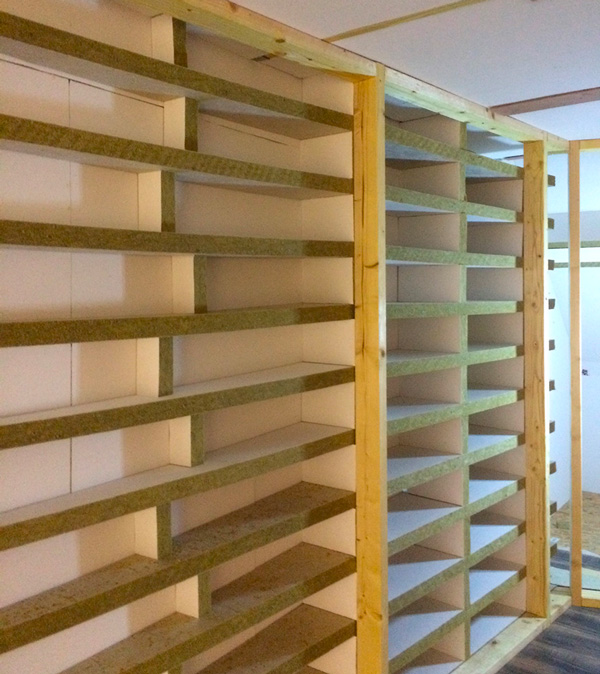
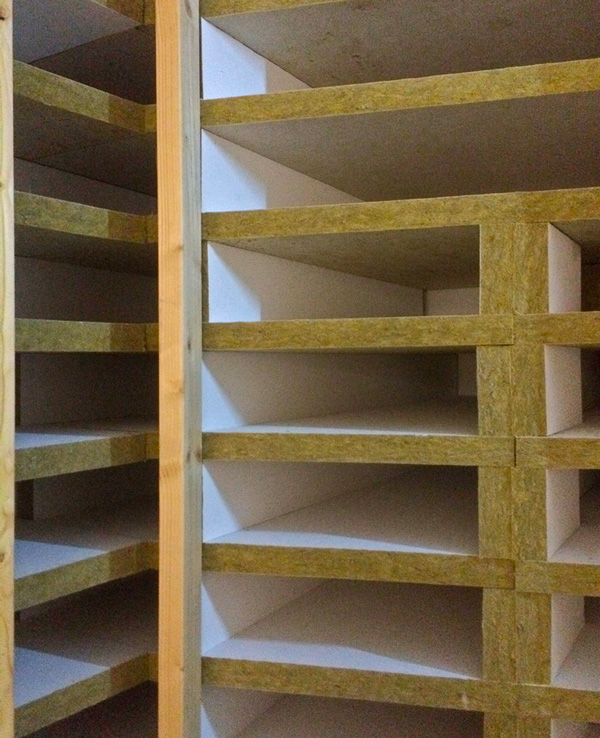
“I didn’t build my current monitors. I preferred to call my friend Laurent Delenclos (Bellote, if you’re listening…) and together we installed and aligned some large JBL M2 monitors, with which I am extremely satisfied. The distinctive feature of this monitor is that it maintains perfect balance regardless of the required listening level, be it loud or very soft.”
“It features a perfect phase curve because it uses FIR filters and the very special D2 ring driver. It’s an enclosure that I really like, that I get along with very well. With these I’ve even discovered things in my old mixes! I supplement it with a small JBL Series 3 monitor to have a sound that’s closer to the average person’s speaker.”
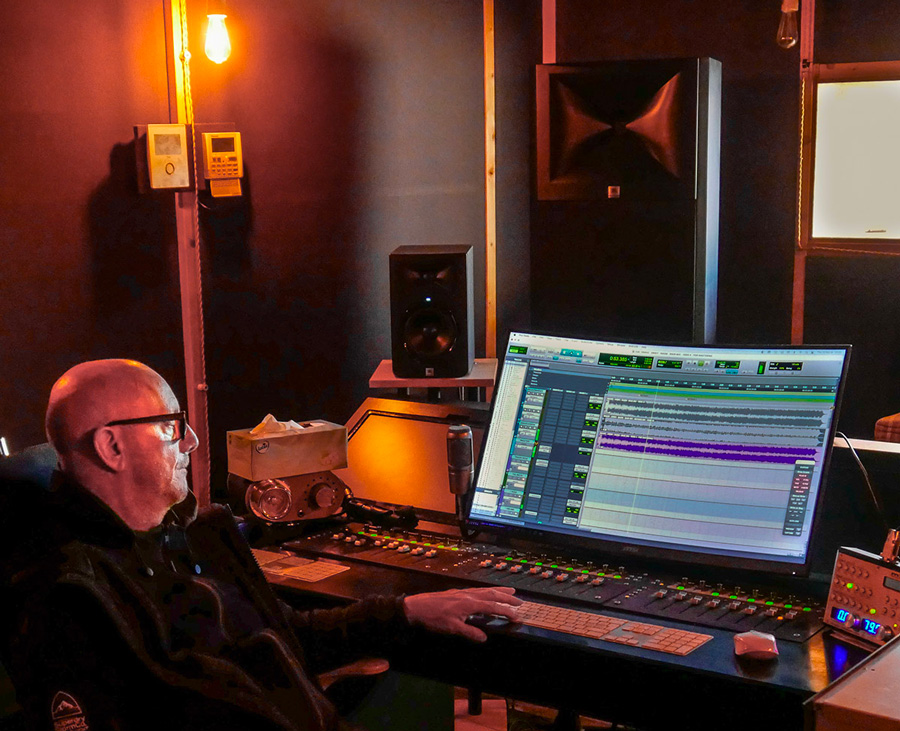
“My workstation is Pro Tools that I use in native. I think it’s great to work natively in the computer. There’s no reason to use a DSP anymore, unless you need a huge amount of simultaneous input and output while mixing.”
“In my case, managing a maximum of 64 physical inputs and 64 physical outputs natively suits me perfectly. For this studio it’s perfect.”
“I never have any problems with latency, as long as I’m careful not to use limiters or maximizers that need to analyze the signal upstream in order to work, and as long as I don’t leave tracks without input assignments.”
I still use four Artist Mix (formerly Euphonix) controllers for mixing. I’m very comfortable with them, although four S1s would be welcome, maybe in the near future… still, they are my favorite Pro Tools remotes, and I never mix with the mouse.”
“To feel the gain movements you want in a mix, there is no better way than fader movements. The mouse is used enough for the rest of the work, editing, selecting, copying, etc…”
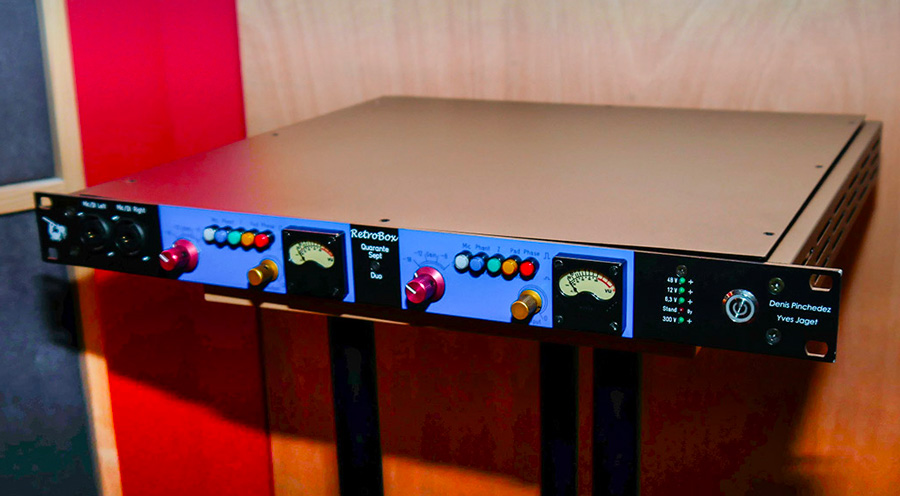
“As far as audio peripherals and outboards are concerned, I now only use equipment that I build myself. You will also find devices from Denis Pinchedez’s Retrobox brand, with whom I’m collaborating on the design of new devices such as the Duo.
It’s a replica, in a stereo version built into a single rack unit, of the famous preamp used in the Beatles’ recordings at Abbey Road studio, the REDD47 from EMI.”
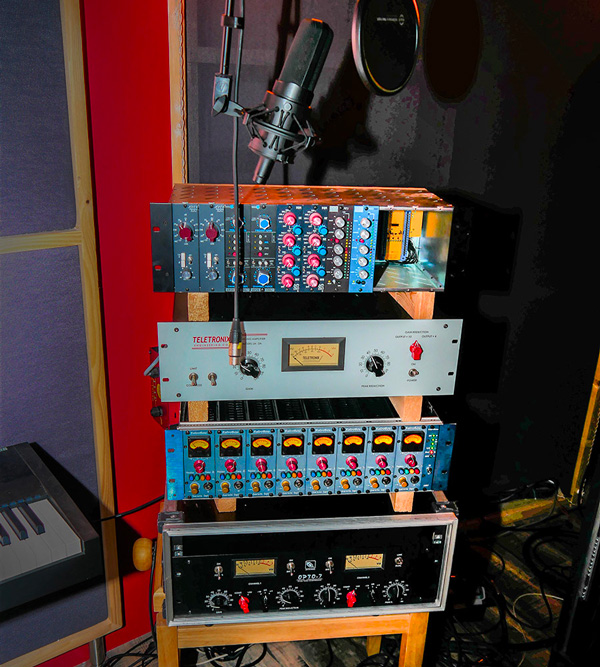
“Why 47? That’s the potential gain of the preamp. When they needed more gain, they would use two of them in series.”
“On the whole, in this studio you can find the best of analog: with three LA-2A compressors, a Fairchild 670 compressor (soon to be two of them…), eight Retrobox REDD47 preamps, one Retrobox DUO, eight 500-format modules, including two Neve 1073 Don Classics, two Capi VP28s, two Neve EQN 1084 Laz Pros, and two Hairball 1176s.”
“As far as my microphones are concerned, I’m a fan of Audio-Technica and I like the top of the line ones, like the AT4060. I often make albums entirely with AT microphones.”
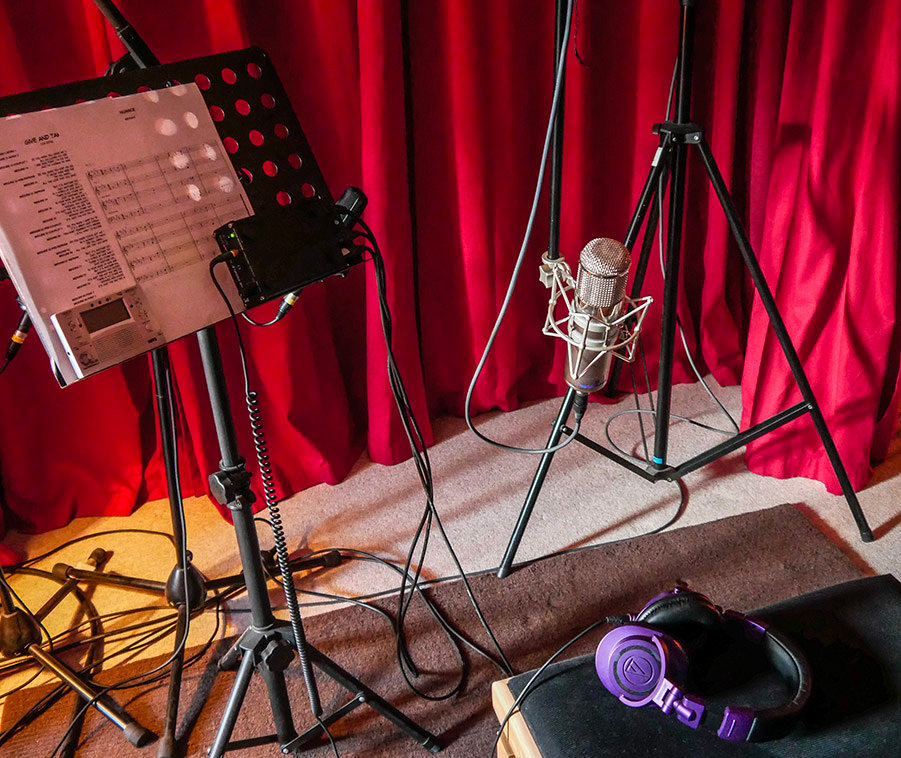
“And just recently, I’m particularly happy to have met an incredible DIY enthusiast specialized in the development of audio equipment, Jordan Champlon.”
“Combining our two names, we are starting to build some mics based on the famous U47 tube and U47 FET mics, which are among my favorite mics. The first ones are being tested and they are way beyond what I imagined.”
SLU : How long have you been making DIY equipment?
Yves Jaget : Yes, I like it very much and there are very good kits that allow you to build very nice units quite quickly and on a more reasonable budget, of course. I must have built 180 devices so far.
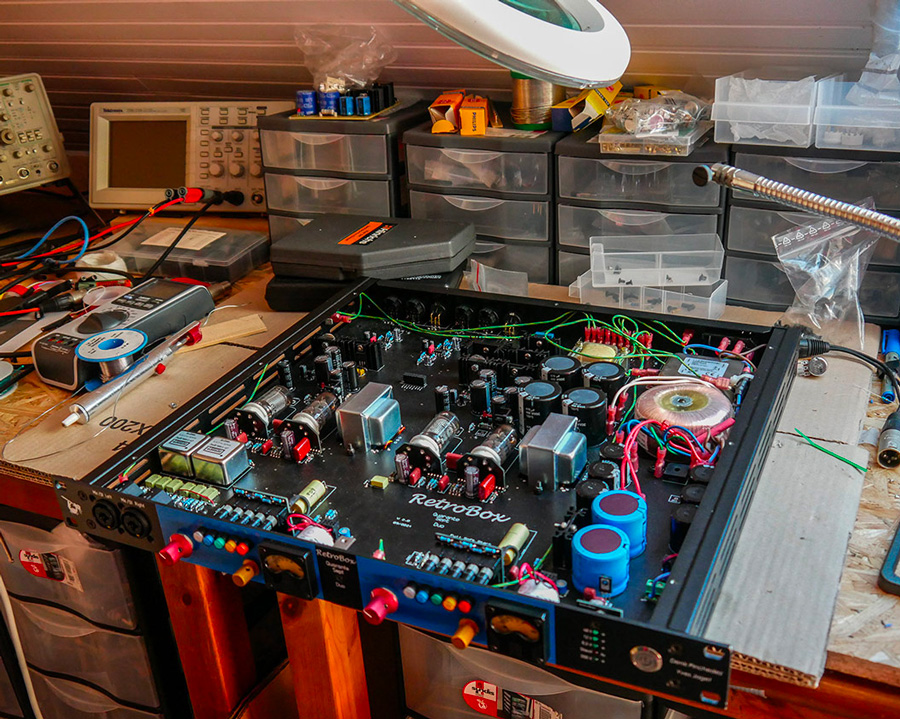
If I had taken a break while I was working on my previous studio, Yellow Sub, I got back into it very seriously for the Zazie tour in 2011. I had decided to build the entire outboard kit for the tour.
At the time, I went to see Eric Alvergnat, president of Dispatch, who already knew how I would make particularly daring technical gambles. He stayed with me most of the way. I explained to him that I wanted to build all the outboard for the tour and that I needed help to buy the components… and he obliged. He advanced me the budget to build the first devices. At the same time, he demanded that a technical listening committee be formed to validate their quality by comparing them with the units in their stock.
As a result, I moved into the Dispatch workshop, very well supported by the late Michel Boterf and by Denis Pinchedez, and I built 56 devices in 500-format rack units, including preamps, EQs and compressors, so nine full 16U racks.
In the do-it-yourself world I didn’t go unnoticed, even in the United States. For the record, Igor Kapelslki – from whom I bought them and who, unbeknownst to me, was also a fan of Zazie – had delivered the kits to me with, as a surprise, all the front panels marked Zazie Limited Edition!

Engineer and partner of the famous mobile studio Le Voyageur, Yves Jaget has extensive experience in sound recording and mixing of live concert albums.
Credited on more than 150 live albums, he shares his know-how with us by going through his latest production, the live album Tout au Tour, recorded for Tryo’s 25th anniversary during an exceptional concert at the Accor Arena, with numerous special guests.
SLU : What happens when you decide to record a live show? How do you go about the recording? Do you have any particular guidelines?
Yves Jaget : With the latest gear, you can easily take the signals as direct output from the microphone preamps of the live console. This is what is commonly practiced. The use of an additional external bus, like I used back in the days with Le Voyageur, is extremely rare these days, except in complex cases like here, where there is also synchronized video capture, and therefore it is good to distribute the tasks to minimize all the technical risks as much as possible.
This live album project was done in collaboration with Stéphane Plisson, the live sound engineer for the concert. We have a cooperative relationship that allows us to share projects without any ego clashes. Stéphane is someone with whom I can even mix easily with four hands, which is rare in this profession… and because of this, I’m happy to work often for his company MAWIP. The show’s a one-off. A single date. He asked me beforehand for an ambient miking plan, which I provided, since I thought it was good for the Accor Arena, a room that I know particularly well.
The signals are taken from the MADI stream straight from the console preamps. This is simple and efficient. One small drawback, of course, is that you are not necessarily in control of the levels of the preamps and sometimes some of the sources can be processed. However, don’t worry, today’s processing allows us to rise above many problems like these. The requested format was 96 kHz, which I find much better than 48. For me, 96k is like the “analog of digital”.
SLU : Just a little trivia about 96k: I think you were the first to use a 96 kHz sampling frequency in France, weren’t you?
Yves Jaget : Yes, it was in the studio in 1996 – I never made a big deal of it; just a happy coincidence – for the master of Michel Jonasz’s album, Soul Music Airlines.
I used the first direct-to-disk Sonic Solutions capable of working at this frequency. This album was then mastered by Bob Ludwig in the USA. It was the first master that Bob received in 96k, which – for the record – caused him to also have to acquire his first 96k station to make it. Since then, I have always worked in 96k.
SLU : All told, how many channels are you mixing on this record?
Yves Jaget : 116 channels. To cover the central stage, plus a small “B” stage in the middle of the room for an acoustic set, as well as about twenty guests. There is a big percussion kit, guitars, bass, keyboards and 20 vocal microphones. And you can’t forget the ambient mics, with 18 dedicated tracks. This requires a rather serious and solid mixing setup, to manage the 96 kHz and 182 plug-ins used in the session.
I had the courage to do it with the new Mac Studio, equipped with the new M1 processors. It was a bit crazy for me to use the first version of Pro Tools capable of running on these new Macs. I admit that I had to work at it, but the Avid hotline was extremely effective. That’s just how I am: I can’t resist using any technical advances. But of course I had my old Mac ready in case…. I didn’t have to use it, I was finally able to mix with all the power of the Mac Studio.
SLU : How much time was there for this project?
Yves Jaget : Here, the concert mix for all the different broadcast media required 28 days of work for both of the mixes, the album version and the video version. The concert video includes more than two hours of live, while the album lasts only 70 minutes. Actually, some sequences that are necessary with the video mix have no reason to be in the live album. Also, the maximum duration of a CD limits that of the album.
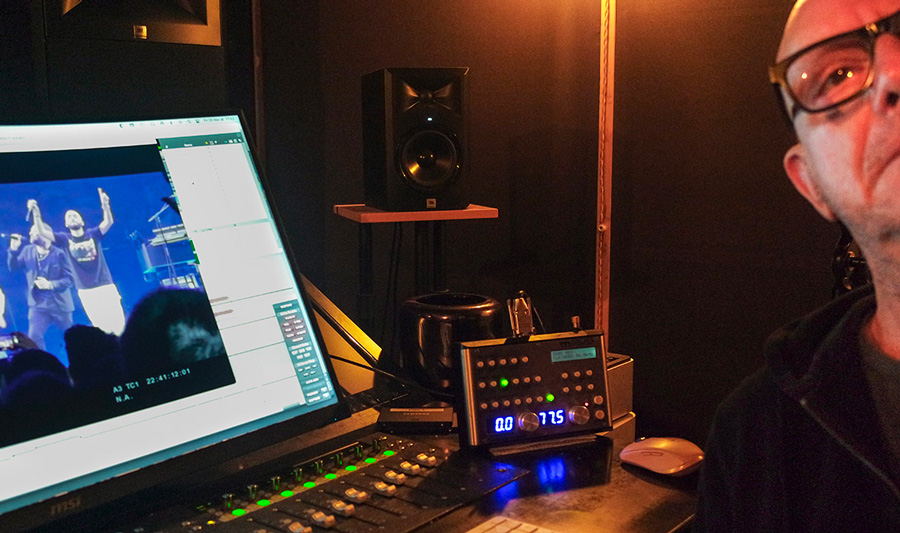
SLU : What method did you choose for mixing? All internal in Pro Tools? External processing?
Yves Jaget : On this type of project, there are too many tracks to work with to be able to work in analog. Also, there are so many different versions of the mix that it would be impossible to do it with analog recalls.
The level of automation in a live show is also extremely high. The processing is very different from one tune to the next! You just have to imagine the chain on the kick drum that changes from one song to another, according to the musician’s wishes. The only analog processor I keep is the Fairchild 670 on the master, which packs up the output nicely. Once you put it the bus, I guarantee you you won’t take it off.
SLU : Does the video impose particular constraints on the mixing work?
Yves Jaget : Yes, first of all, it requires you to monitor the video shots. You can’t mix without considering the image. The pushes I would do in an album mix wouldn’t work with the video. But if a musician appears in the image for even two seconds, you have to bump him up in the mix.
In fact, I mixed the video version first, and then I did the album mix, which is very different, because of the absence of the images. But you have to be careful… I do the first few passes of automation without video, so as not to be influenced by the image, which has a distracting effect and would cause you hear certain things that absolutely must not be heard.
With the video, there also has to be a constant presence of the audience. They must therefore be part of the mix. This is the biggest challenge in live mixing: being able to leave the ambient mic tracks open without spoiling the mix. That’s what I love. Personally I like live albums with a high level of ambience.
Here, I made several versions of the mix with different levels of room ambience. The production chose a rather subdued level of ambience. This is the difficulty of a live album. To always give the impression to the listener that he is in the room, without polluting the global mix.
SLU : And do you have a particular method for this?
Yves Jaget : First of all, I realign the ambient mics. Just like using a clapperboard in cinema takes, I clap my hands on stage, in the absence of the audience, for example at the location of the snare drum, which is the furthest point on the stage, and I realign the ambient mic channels temporally so that I only get the volume of the room but not the delays. If, for example you have set up five lines of ambient mics, you can’t have five different delays on your kick or snare drum. The trick is to match them exactly, and then everything will work fine.
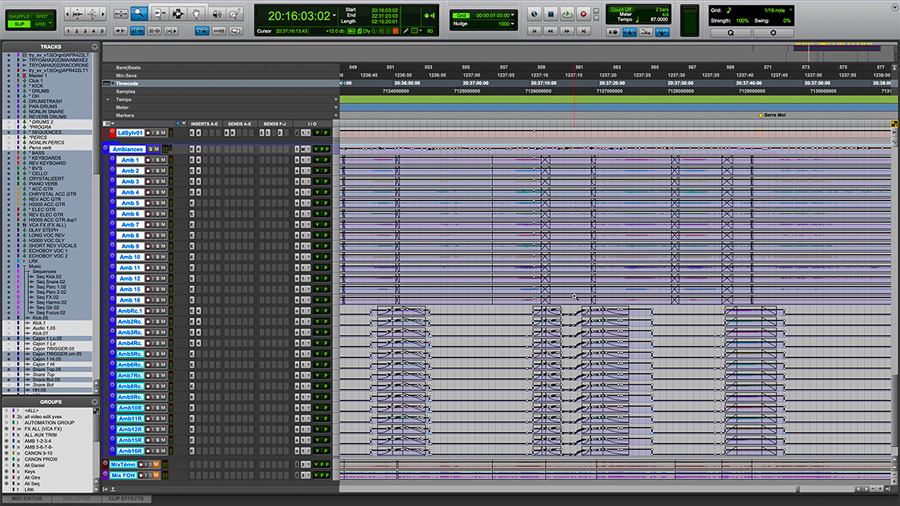
SLU : So you have to follow the video cuts in the multitrack audio?
Yves Jaget : The first thing to do before you start editing is to clean up the whole session. Remove everything that isn’t playing, crossfade inputs and outputs from various areas. Secondly, Pro Tools has extremely easy and powerful editing. When you see the video edit, you already know you’re going to have a fun time reproducing it.
The video edit was done with sound embedded, so it’s fairly consistent. But if you try to reproduce the EDL (Edit Decision List) of the edited video, even if you’re lucky enough to have timecode, it won’t really work. You have to take their edit and manually reassemble all the songs on the video. So you have to redo all the inter-title edit points on all 116 tracks.
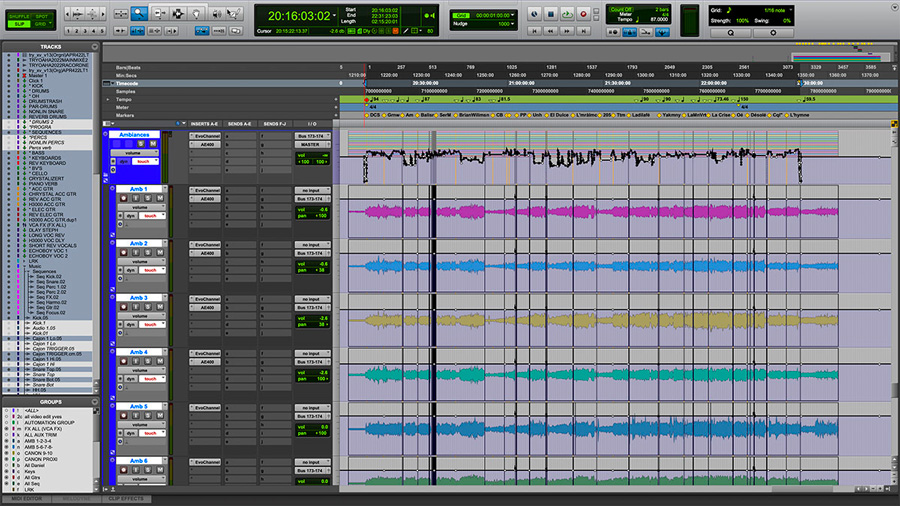
With Pro Tools it’s still easy, using edit groups. All the tracks become one block and when you cut, you cut the block. Using shuffle mode, you move through the timeline of the show, splicing tracks as you go. Once the clip is aligned to the video, you can ungroup the regions and manage your editing with precision, track by track.
If you need to restore synchronization by finding a few samples here and there, you can do so at will during the applause between tracks. If, on the other hand, a video edit is impossible to reproduce correctly in the audio because it alters the musicality, then I’ll flag it so that the video team can readjust its edit.
SLU : What about the vocals in the live recording? It’s problematic, isn’t it? With the wireless mics, the recording conditions, etc…
Yves Jaget : Wireless microphones have come a long way. There’s nothing really to complain about. The particular problem with live performances is what the mics pick up. And here, it is especially the large number of guest performers. While everything is fine for the members of Tryo because it’s their show, it’s more complicated for the guests.
Fortunately, the singers of the group have a knack for welcoming the guests and their job is to help them get into the songs. We end up with voices that are often a little more timid, and we have a lot more ambient sound. So we have to clean up a lot with the equalization.
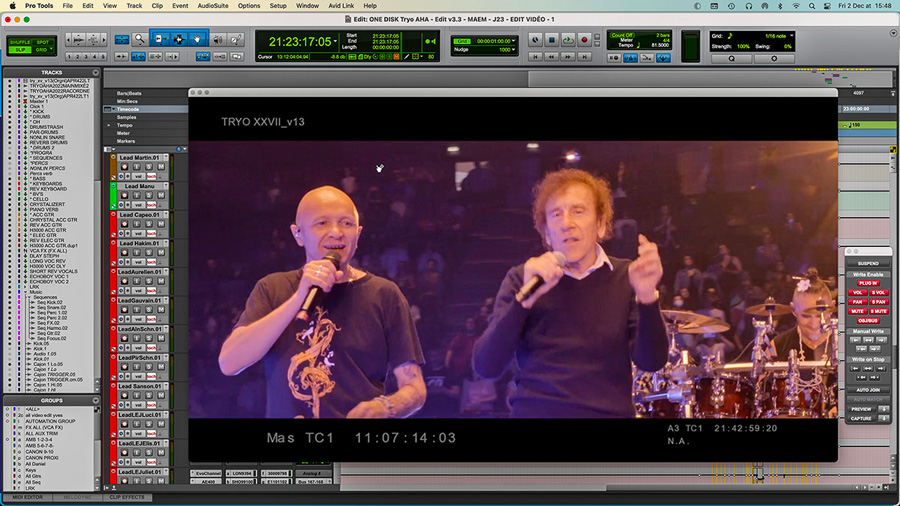
We also have to match the voices, and here I have to mention the very important role of the wireless mic engineers. They already do a remarkable job in perfectly matching the level of the voices, which helps us enormously. Another problem with a high level of ambient sound in the voice mics is that it is impossible to cut them.
Since the level of the room sound is high, cutting it off would greatly distract from the overall mix. So you have to find the right compromise. In reality, you have to play with the flaws. Often, the more you try to mask, the more it will be heard. So don’t hesitate to play with the flaws that you’re depending on.
SLU : On this album, the vocals are very nice. Do you use any particular tools on them?
Yves Jaget : All the voices are heavily processed. I use my own signature plug-in, Flux’s EVO Channel, because it has an EQ and a compressor that I obviously like a lot. Then I use McDSP’s AE400 active equalizer. With this processing, you only compress a particular EQ and not a whole frequency band like a classic multi-band compressor. It allows you to handle frequency problems with precision.
I always use a lot of stereo stems, one of which is for vocals and on which I use a multi-band compressor from Alchemist or the ML4000 from McDSP to control and avoid problems in certain frequency bands. This is a very common problem here, where several voices are singing at the same time.
Then there is of course a voice reverb, and I use a lot of the echoes that Stéphane Plisson uses on the voices, with the Manny Delay plug-in from Waves. It’s very important to have these tracks because the echoes he uses during the concert are obviously heard in the ambient tracks. It is therefore important to have them in the live sound to reproduce the effect.
The ideal plug-in racks for total voice control:
SLU : And a touchy subject… Do you cheat, do you retune?
Yves Jaget : Yes. It’s tough not to admit it. Honestly, on a three-hour show, it’s hard for a singer not to make little mistakes. And even more so on a one-off show where there are a lot of unplanned things and a lot of guests. So, when it’s necessary, I change the track and I do some pitch correction in a very reasonable way.
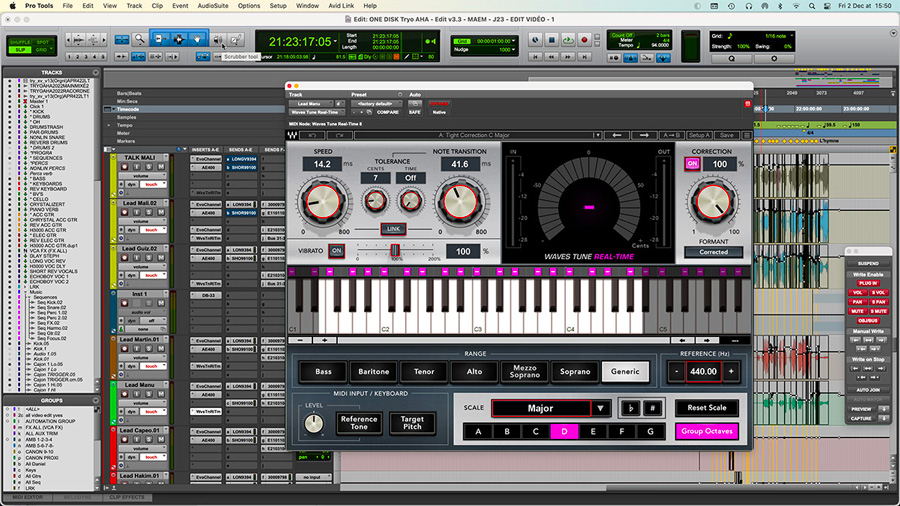
Here I used Waves Tune, which works in real time by automating the pitch changes. It is important to understand that today’s audience is more and more used to hearing extremely accurate and well-matched voices, and it is important to take this into account on a major production. But always in moderation so that everything remains natural.
But you have to be careful: never forget that the original voices are in the ambient tracks. So in a mix like this one where the room sound are very prominent, you should be very careful not to force the pitch corrections too much, because the original voices in the ambient tracks cannot be corrected. If you ever need to make a serious pitch correction or a placement correction, you will have to rework the ambient sound as well, otherwise the result will be even more disastrous. And this takes a lot of time, when it’s not simply impossible…
SLU : And when you have a single take to get it right, like here, and at some point there is a major problem?
Yves Jaget : A live show doesn’t preclude re-doing or re-recording certain parts. Here, we didn’t have to do that. Whenever it is necessary, it’s often possible to find other shows on a tour that have been recorded, even locally on the console, and you can find and adapt a part. That’s an extreme case.
I also often take a similar part from the song and adapt it, for example an acoustic guitar that is too timid at the beginning of a song can be replaced by the same pattern played in the middle of the same song. With the current stretch tools, this is quite easy, within reason.
SLU : For the soundscapes… do you use the natural sound of the room of the show or do you add other reverbs?
Yves Jaget : I added some. The first reverb I do imitates the room. I do this very well and I use Avid’s ReVibe II to do it. It’s a big, complex reverb that I’ve been using for a number of years, and it offers many parameters to simulate all types of rooms. I also use Eventide’s UltraReverb.
I work on my reverbs when I have time to create my presets, because when I’m mixing it’s just impossible. With this main reverb, I bring everything into one coherent ambience. Here it’s about a 2.6 second reverb, with a particular color. I equalize a lot and drastically whatever goes into the reverbs, to manage their color. For this, in Pro Tools I use the track preset. When I make a reverb, I create my processing chain with its pre-EQ and I recall the whole thing.
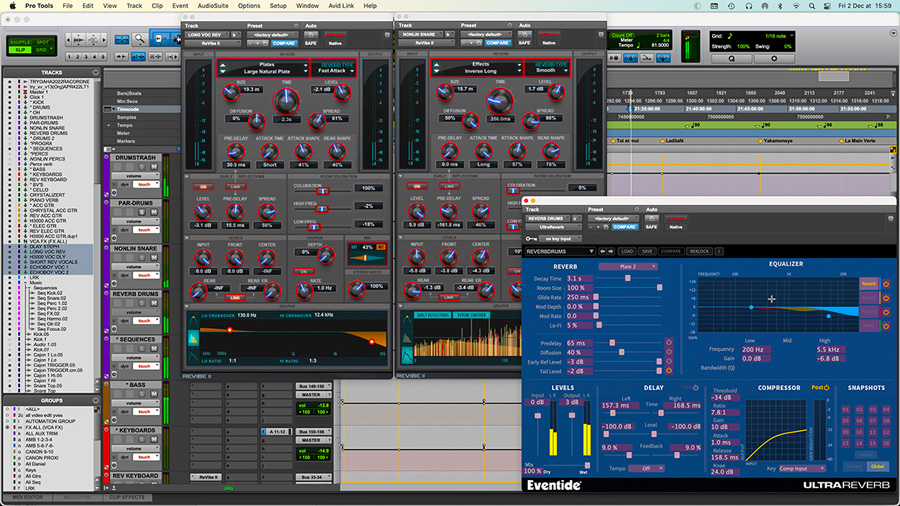
SLU : Speaking of reverbs, how does it work with the ambient tracks?
Yves Jaget : There are a lot of ambient mics. Some are at the front of the stage, but most are scattered around the room, under the PA. You have to feel the mass of the audience. The ambient microphones have to be at equal distances, close enough to the audience, but still allowing a wide area to be picked up.
They are essentially cardioids and I don’t use shotguns unless, for some reason, I need a very precise pick-up of the fans in the front row, for example.
I also like omnidirectional mics very much for their naturalness, I put them in the middle of the room. I also place a stereo pair at FoH, directed towards the system to have a nice stereo image of the house sound from the audience. It’s a very big, generous sound, very easy to add to the room sound. You need a lot of ambient tracks to have a massive effect and to have as many different types of audience reactions as possible. It also greatly improves intelligibility, which is very useful for more intimate moments, such as when the audience is singing the words of a song.
From doing live shows, I know that the ambient sound is very important. You can miss anything in a live show, except the ambience, because you can’t do it again. I’ve always said to my assistants who do live shows: “Yes, it’s a pain to set up the ambient microphones. You’re going to have to go all the way up there, you’re going to have a hard time placing the mics… But it’s indispensable and unavoidable”.
For the ambient mics, I’m fond of the Schoeps CMC6 plus the MK4 cardioid capsule. Their sound is extremely nice, very full, massive without being aggressive. Below are the recommended positions and microphones for the ambient sound:
3-4 5-6 9-10 11-12 : Schoeps CMC6+MK4 or DPA4011 or Neumann KM184
1-2 7-8 : Schoeps CMC6+MK2 or DPA4006 or Audio-Technica AT4022
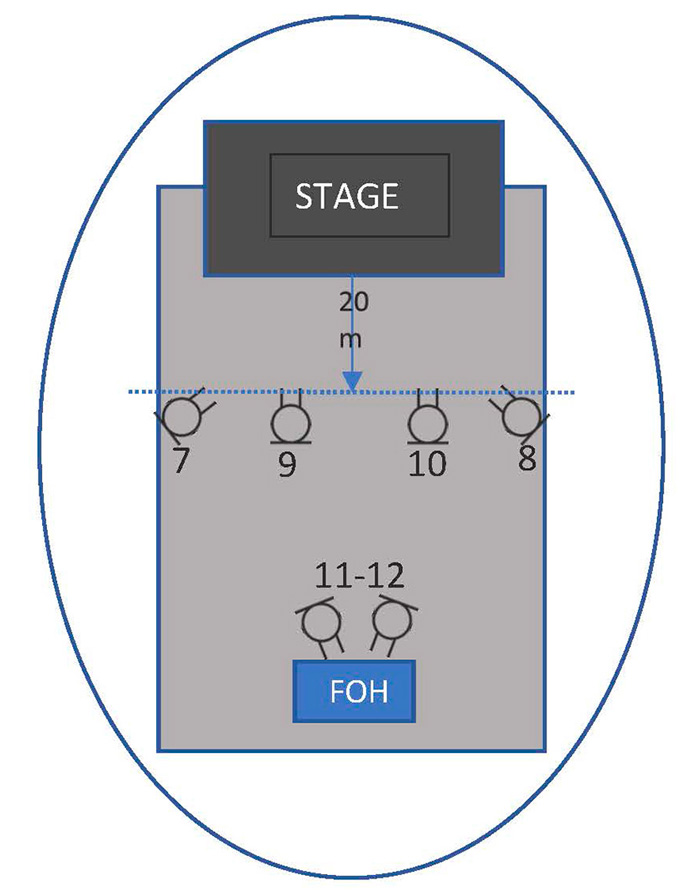
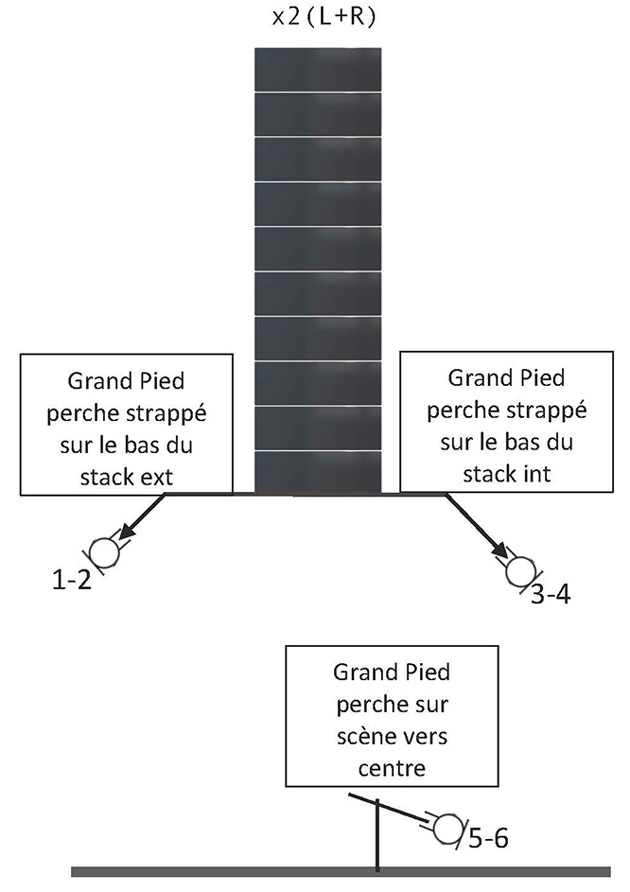
SLU : What about the drums and percussion?
Yves Jaget : With the miking done by Stéphane Plisson, who is very demanding on the quality of the drum kit live, I never have any problems. He takes great care in choosing the microphones and their placement. So I have impeccable tracks. With Tryo, we also have a lot of percussion. The bass drum is also often replaced by a cajon played with a pedal. It’s not easy to pick that up live.
What I do in some cases is to add an additional kick sound. For this I use the Trigger 2 plug-in, in which I have created a nice bank of kick and snare sounds. This allows me to establish a rhythm sound very quickly.

SLU : In the album, there is a surprising, very intimate song, Chant de bataille, with a lot of emotion. Maybe this is not an especially easy track?
Yves Jaget : Mali is very emotive when he sings this song. He talks about a strong subject linked to his personal experience with the problem of bullying at school. It is an acoustic song with very few instruments, so it’s the room that is being played. You can feel the silence in the room very powerfully. You might call it a “deafening silence”. You can hear the emotion in the room. Its silence becomes oppressive.
For this track, the ambient tracks are very open. In a lot of live shows, there are tracks that are full of emotion and you always feel this heaviness of the silence of the audience that really speaks. Of course, technically, the more ambient microphones there are in the room, the more you pick up this kind of weight in response to the singer’s emotion.
SLU : What about keyboards and guitars?
Yves Jaget : The same musician plays bass and keyboards, and there are also some sequences. There’s nothing special about the guitars. The amps are backstage. The instruments are good, so I have sounds that are quite reasonable. The foundation is very solid between guitar and bass. For the recording, it’s simple: we add a direct box and a Retrobox tube preamp.
In the mix I compress, sometimes I add chorus and delays to add some spaciousness. I use the Sound Toys Crystallizer a lot on the acoustics. Each part has its own effects. Everything is reprocessed with reverb and effects and put back into the mix, so that it’s in the room and still sounds good.
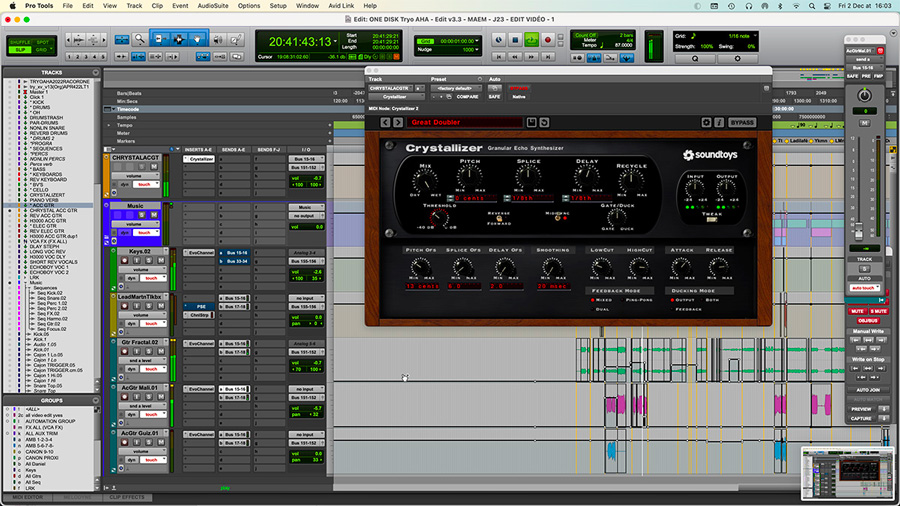
SLU : Is there one song that is more complicated than the others?
Yves Jaget : The most complicated songs are often chronologically the first ones played in the live shows. There’s a kind of evolution that takes place between going on stage and coming off stage. The first ones are the trickiest, and in the recorded mix it’s a bit like the live show. You progress as you go along in the mixing of the songs, and when you get to the end, you have made progress, you have found a formula that works better. It’s just like in the show.
So I often go back to the first tracks to make some corrections, because I have a better grasp of them. The rhythm section is often a little less solid at the beginning. Also, with guests, some voices can be a bit more stressed than others, especially depending on the amount of time they have to wait. The longer you wait to get a guest on stage, the less control you have.
SLU : In the live shows, do you keep the original order of the songs or do you sometimes change it?
Yves Jaget : Not in the video, of course, but here in the album version, some tracks have been shifted chronologically. I was therefore quite stuck, because some of the video edits had to be reworked. But that’s the way it is. When you remove tracks, which is the case for the album, there is no longer the same structure of the show, the same flow. It changes the dynamics of the show, which leads to adopting a different order.
SLU : With your extensive experience in mixing live albums, do you have any special advice?
Yves Jaget : Ambient tracks are the key. They account for 60% of the success of a live record. Don’t hesitate to use a lot of them. It’s a pain; it’s complicated. You have to try to even out the sound and therefore place the microphones from above and bring them down as low as possible, while maintaining a consistent distance from the audience.
When you’re lucky enough to have a mobile studio, you can add microphones, but nowadays it’s more difficult. The resources are more limited in live sound recording, you get the sources from the stage box in digital and the ambient microphones with a small console added alongside.
Just for the record, I often re-trigger drums on live shows without telling anyone. When listening to the final mix, it’s not uncommon to hear the musician say: “can you hear my sound from the kick, it’s perfect isn’t it?”. They think it’s great and take it as their own. It’s perfect. It means that the work has been done well. On the other hand, when it comes to the ambience, there’s no room for error.
SLU : How do you balance the processing so as not to lose the atmosphere of the live event? Tips? What are the limits that you shouldn’t overstep?
Yves Jaget : People want to recapture the feeling they had in the middle of the room. I always start by opening up the ambient tracks and finding an overall sound that suits me to feel the massive aspect of the room, with a little bit of low end, but not too much, so as to keep it natural. It’s the low end that’s difficult to manage.
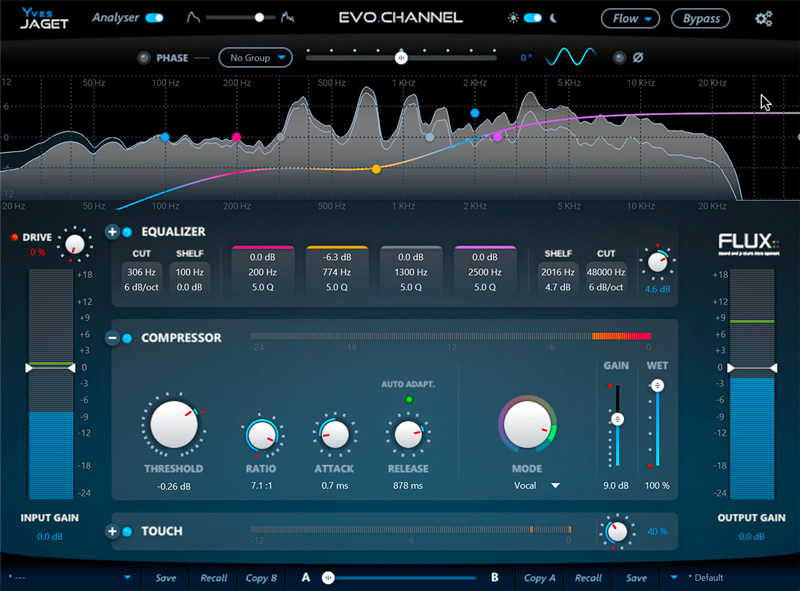
I’m always looking for the right compromise between how much rumble there is in the bottom end of the room, and what I want to achieve in terms of a big image. With a full arena, you need some rumble, but you also need to be sensible.
For that, I like to use 6 dB/octave filters, so that I can turn them up super high and keep a kind of balance at the bottom that is musical.
In my EVO plugin, I set this 6 dB/oct option because I find it the most musical. I prefer to set filters at 260 or 300 Hz and keep a natural slope at the bottom that is musical, rather than trimming to avoid getting it dirty.
At a certain point, what you let through in the ambient sound can’t go through in the direct sound. You have to find the right compromise. I also often have to de-ess the ambient sound. With a PA at 70 meters, the ambient mics pick up sibilants which are sometimes sensitive in a sound system and which become unpleasant if the system is not well tuned. This makes it possible to control the high frequencies, so that it does not sting your ears on voices that are already a little modified by wireless microphones. In short, to find the right compromise between the dirty nature of the ambient sound and the realistic character of the direct sound.
SLU : If the FoH sound isn’t good, this will make the mix more difficult?
Yves Jaget : Yes, of course. Problems with the front of house sound can be immediately perceived in the ambience. When you work on shows where the music is very loud, it’s a real problem. In rock music, with the enormous pressure in the room, it’s hell in the ambient tracks. The acoustic pressure of the music is always higher than what’s going on in the room, so it can be very complicated to get the details of the audience sound.
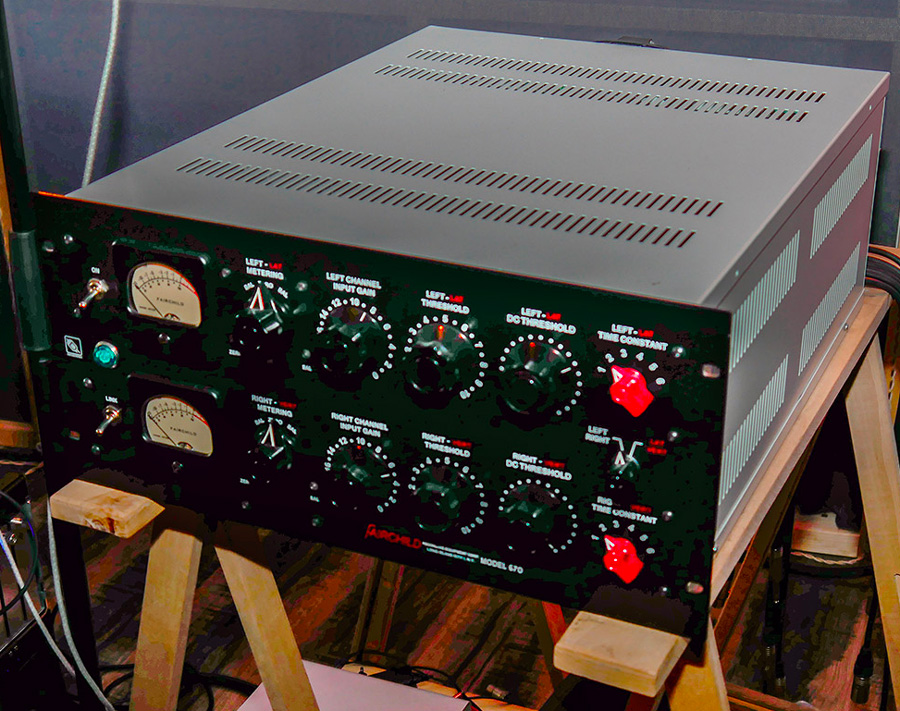
SLU : How do you manage the dynamics?
Yves Jaget : I use the Fairchild 670 for the texture of the sound it brings to the master. In addition to the Fairchild, I have two plug-ins for output processing.
The TG Channel from Waves, which is an emulation of the Tegeler Audio EQ-compressor, and the ML4000 from McDSP, a multi-band limiter compressor, which is absolutely awesome and that I really like.
I use it on all the live shows I do, and even on TV shows and entertainment, like Nagui’s show, where I use it on air. I really love it.
SLU : What about mastering?
Yves Jaget : The record was mastered by Simon Capony, from Basalte Studio in Clermont Ferrand. I have been working with him for many years. I try to avoid sending him “rotten” mixes. I give him some leeway, but not much. That’s enough for him to do his job, to generate mixes with different level standards for different media, CD, Video and TV.
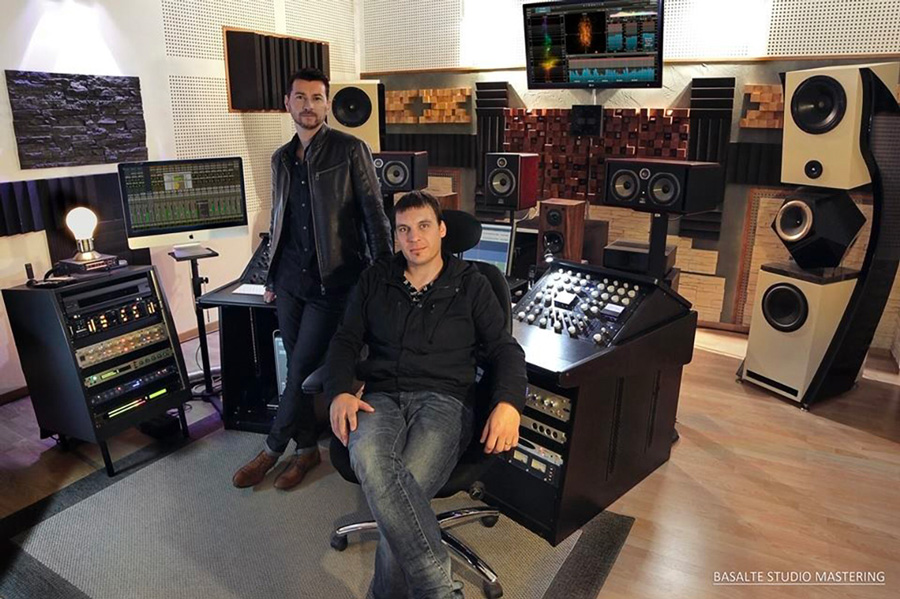
SLU : An album mixed in stereo… any plans for a mix using spatialization?
Yves Jaget : For live performance, the most appropriate choice would be immersive, as this is the best way to represent the listening experience of a live venue. Here, the choice was stereo, but producing an Atmos version isn’t out of the question. But it’s always a matter of budget. I’ve mixed a few live shows in multichannel. It wasn’t easy at the time, because we didn’t have the tools.
Now with Dolby Atmos, we have software and plug-ins that are very well suited to this, like Flux’s Spat which allows you to simply move your pair around and spread them at will, to impose reverb times per instrument, with extreme ease and speed. It’s quite a pleasant process now.
A real Dolby Atmos installation requires listening room dimensions that I don’t have here. Otherwise I would have installed it. But you need a budget to do these mixes. Everyone is pushing for immersive sound, but immersive experiences are often done for projects that are very well supported financially.
SLU : Among all the live albums you’ve done, do you have any special memories?
Yves Jaget : Of course: Pink Floyd’s Pulse in 1994 with Le Voyageur, recorded during 23 shows. We did the recording in the mobile studio. It was the first time I went on such a huge tour. Of the live shows I mixed, there was, of course, Zazie’s Rodeo Tour, which I loved a lot. It was a very good live show with very good sound. I did everything, the live mix and the album mix.
SLU : Do you have any stories for us?
Yves Jaget : Oh yes! The live recording that never existed…
SLU : What do you mean?
Yves Jaget : The late Patrice Cramer, my associate in Le Voyageur and an excellent sound engineer, and I were invited to make a live recording of a reggae band at the Zénith in Paris. It was a kind of festival, there were six bands, so we had to wait to do it. The manager the band had told us that he would come and tell us 30 minutes before we needed to start recording. We were chatting quietly, Patrice and I, and when we finally saw the guy come into the bus, he said, “So, did it go well?”… and we never recorded (he laughs).
SLU : Is there a live show you’d like to do?
Yves Jaget : I have many, but it would have been a dream to mix Coldplay’s live show in Brazil. There is a culture of singing in that country. The public sings. It’s huge. 120,000 people singing the same song. It’s really overwhelming. I would also love to mix Lady Gaga’s shows, and Orelsan’s live shows, yes I would love that.
I’ve always been into live music. Even though the Accor Arena is impressive, you have to admit that a stadium with 120,000 people is amazing to do. The uproar of the crowd when the house lights go down in a stadium, it’s a whole other experience. You just can’t believe it. With Le Voyageur, I recorded shows with huge crowds, the pressure build up is colossal. It’s really awesome.
SLU : Are making a studio album and a live album equally exciting?
Yves Jaget : Mixing a live album is exciting because it gives something to the audience, it represents the concert and it’s like being in the middle of a show. In a studio album, the best thing is the freshness and the constant creation.
On the other hand, a little trick I noticed is that when you start a tour with some flaws, you always end the tour with them. You’ll never fix them. On a studio album, there’s no such thing. The studio is about creation. Live is a recreation, the icing on the cake, the little gift, the consecration of playing the album live.
As you can see, whether it’s a live album or a studio album, Yves Jaget pushes both to their technical limits with a skill that is all his own. A master of the best balance between quality sound and musicality of a composition or a performance, we thank him for his many tips and, if you haven’t already done so, listen again to the albums we have just discussed (see below).
You can find more information on the Mix à l’eau de mer studio website and on the page dedicated to the DIY equipment
Tryo – Tout au Tour (live)
Zazie – Rodeo Tour
Coldplay- Live in Buenos Aires
Pink Floyd – Pulse
.



